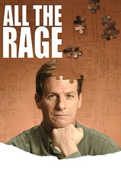Martin Moran on Turning Anger Into Art in the Off-Broadway Solo Show All the Rage
About the author:
It’s not easy to hold the attention and sympathy of an audience in a solo show, but Martin Moran has mastered this very difficult theatrical form. In his astonishing, Obie-winning 2004 piece, The Tricky Part, Moran shared the chilling story of being abused by a camp counselor from age 12 to 15. (If you missed it, read the book version.) Now, Moran has created yet another fascinating one-man show, All the Rage, in which he explores the road from anger to forgiveness. This talented vet of Broadway musicals such as Spamalot, Titanic and Cabaret kindly agreed to reflect on the two sides of his career for Broadway.com. After reading his essay, get tickets to see him in All the Rage at off-Broadway's Peter Jay Sharp Theater.
![]()
I’ve been thinking this week about the fear, the heart palpitations that come just before walking alone on stage. Last night I thought:
“Oh…maybe this particular terror is due to meeting your scene partner (the audience) for the very first time in the first seconds of each performance. It’s always someone different and there’s always the worry they won’t want to play.”
I think this is why, when I find myself sitting alone backstage at the Peter Jay Sharp waiting for the flashing blue “Go-Light,” before a performance of All the Rage, I most want to crawl into bed and hide. I mean, how crazy to step out, start talking and not shut up for 80 minutes. Insane…no?
In 2004, The Tricky Part, my autobiographical solo-show about growing up Catholic and finding forgiveness in the wake of abuse, opened off-Broadway. It found enough success that I spent much of 2005 doing a multi-city tour. I had just finished a six-week run in Seattle and then at San Jose Rep and declared, “Holy Mackerel, enough solo. It’s lonely! Never again.”
The gods must have heard, because suddenly I was putting on a wig to play Sir Robin in Spamalot, taking over the role from the most gracious man on the planet, David Hyde Pierce. I had to keep pinching myself, feeling so amazed to have this job awash in laughter, a full orchestra, blaring trumpets, guided by the master Mike Nichols. Though The Tricky Part had its share of laughs (no kidding), it was about as different a theatrical landscape as possible from this world of Monty Python clowns in pursuit of the Grail. The biggest difference: I’d rehearsed with my scene partners! The audiences were new each night, of course, but after all those weeks alone on stage, look! Other actors! Look at their on-stage eyes. They have lines, they interrupt and make me shut up. There was Christian Borle and Michael McGrath and Steve Rosen—some of the funniest men in the world—cracking the audience and me up. What a joy, what relief! A zany story that somebody else wrote and, for heaven’s sake, not all about the proverbial “Me.”
So I was trotting about the stage, pooping my pants as cowardly Robin, when a question (the question of rage) began to brew in my gut. And, oh dear, that’s how it begins. It presents itself as an urgent question, an imperative that demands an answer. Or, at least, an attempt at an answer. That’s how the “solo” thing begins.
I began to wonder if I had missed a big part of the story in the journey to forgiveness that was at the heart of The Tricky Part. Had I skipped anger in the wake of being wronged by another human being? People had challenged me on this, and it rattled me. The question grew in size and permutations: What is anger’s place in the world, its place in my life? How do anger and compassion live side by side? Is anger useful or destructive? Both? OK, we hurt one another. We get wounded, cleaved. How do we make sense of this? How do we move on? Is forgiveness a part of that? Is anger just as vital? With the ache of these questions growing in my gut, I jotted notes even as I trotted round the Shubert Theatre.
I found myself looking outward at how other people handle fury. My brother, my fellow New Yorkers. I began to work with refugees, survivors of torture, seeking asylum. How in the world do they find equilibrium? The writing began to build and so then the impulse to share it. To read it aloud, to begin work with my collaborator (the intensely devoted and brilliant director Seth Barrish). And in that most basic form of theater—first-person storytelling—a “show” slowly took shape. Over many months and several working titles, out of town readings and workshops, All the Rage was finally born.
Perhaps it all has more in common with Spamalot than I ever imagined. Whether playing a Knight or the Self, a search for the Holy Grail, the meaning of life, the simple need to tell a story.
Whether I have truly answered the questions seems not the point. Perhaps it’s the very search, the attempt to connect, that matters. But here it is, a couple blocks west from where I played the cowardly Robin, my heart pounding nightly. It’s scary; thrilling, too. I can scarcely believe it’s happening. Never say never.
